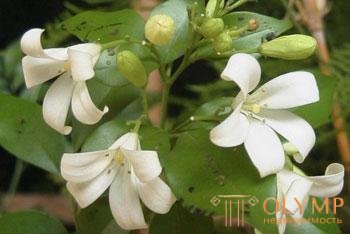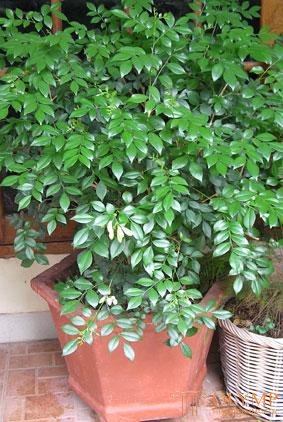

For several years now, a wonderful representative of the family of rutaceae (Rutaceae) - Murray paniculata has been growing, blossoming and bearing fruit in my house. Evergreen tree in nature reaches 3-4 m in height. Its homeland is the humid tropical and monsoon forests of India, Indochina and Indonesia. In room conditions, Murray is never above 1.5 m and always looks elegant, like a Christmas tree. The bark of shoots with age becomes light gray. Leaves are pinnate, ovate leaves, dark green, shiny, on short petioles. The plant blooms almost all year round, delighting with small (up to 2 cm in diameter) snow-white, very fragrant flowers, solitary or located in the upper thyroid inflorescences. Red fruits are edible. They are tied up with self-pollination, but it is much better to hold an artificial one. For this, pollen from one flower is transferred to another by a brush. 
Multiply Murrayu equally easy seed and cuttings in the spring and summer. For sowing, mix leaf soil and sand in equal parts. Seeds are buried at a depth of 1 cm. As the seedlings appear, they are seated one by one in small pots. It should be noted that seedlings bloom very early, while they are still very tiny.
On cuttings I take half-stiffened branches with 2-5 leaves. At the bottom I make a cut directly under the kidney. Before planting, the bottom sheet is removed. After pouring the cut with crushed charcoal, plant the cutting in the substrate, deepening about 1.5 cm. After spraying and watering it with a pale pink solution of potassium permanganate, cover it with a jar or plastic bag. After 2-3 weeks, callus appears, and roots form a little later. After 1.5 - 2 months, the plants are planted in small pots.
Few people know that Murrayya has phytoncidal properties.
Care for Murray is determined by its biological characteristics. First of all, you need to consider that the plant needs diffused light. It develops beautifully on the western and eastern windows, southern in spring and summer, you need to pritenyat to avoid burns. In the autumn-winter period, when the length of daylight hours is short, it is better to rearrange the plant to a bright place. Murray is thermophilic, so year-round temperature in the room should be maintained within 18-25 °, although in winter it can be reduced to plus 15 °. With a colder content in the plant buds, ovaries, flowers and leaves fall. This phenomenon is also observed in conditions of insufficient lighting, especially in winter, with high air dryness and disturbance of the irrigation regime (dryness, excess moisture).
Throughout the year, Murray needs high humidity, so it is advisable to spray it daily with water at room temperature. In winter, in addition, I put saucer with wet moss next to the tree. Like other indoor plants, I wash Murrayu under a warm shower 2 times a month. I water as the top layer of soil dries out, then loosen it.
For the first 2-3 years, a young sapling preferably twice per season, transship into a fresh earthy mixture, increasing the size of the pot. The earthy lump is kept whole, without injuring the roots. If this is not possible, it is necessary to cover the crown with a plastic bag or a can for 2-3 weeks after transplantation, after having sprayed the leaves with warm water. An adult plant is transplanted annually, usually in spring, into a mixture of leaf (preferably from under maple or linden), sod land, humus and sand (2: 2: 1: 1) with the addition of pieces of charcoal.
Murrayya is responsive to feed. From organic fertilizers, I prefer to use mullein infusion (1:10), from mineral fertilizers - nitroamofoska or “Riga mix” (1 g / l of water). Because the plant develops and blooms throughout the year, I do top dressing all the time, with the only difference that in the winter I use only mineral fertilizers in half the dose, and the rest of the time every two weeks in turns mineral and organic. Once a month I water the soil with a pale pink solution of potassium permanganate (potassium permanganate).
In the spring pinch the strongest branches. The plant is amenable to pruning, and if desired, the crown can be given any shape.
Что бы оставить комментарий войдите
Комментарии (0)